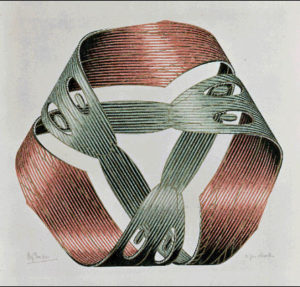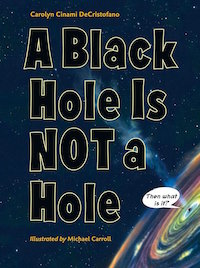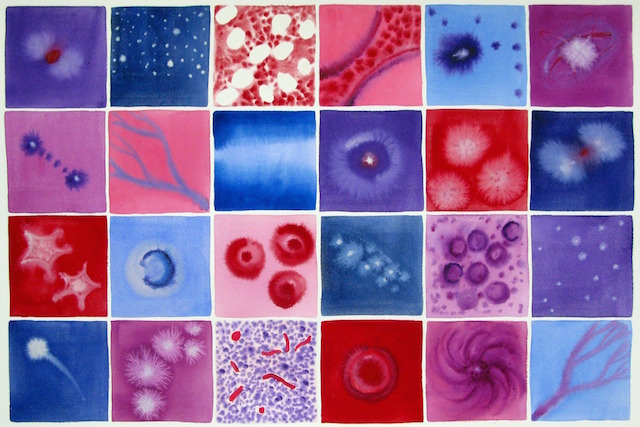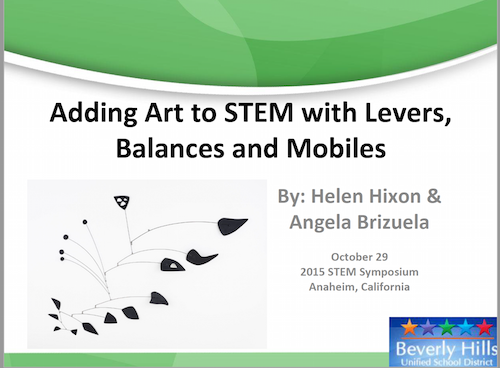STEAMy Thoughts on Blending STEM and Art
By Carolyn DeCristofano
A visitor to an art museum approaches a mechanical contraption encased in glass, entitled “The Butterfly Effect.”
A slender metal rod protrudes through a slit in the glass, with arrows indicating different directions in which the rod might be moved. The visitor reaches out and flicks the rod, setting a series of motions into action.
The disturbed rod strikes a delicate piece of metal that resembles a butterfly wing, which, now fluttering, causes a metallic, flowerlike object to sway. In turn, this oscillation causes another part to move, and so on throughout the mechanism until, far down the line of mechanical pieces, several bits of metal gather themselves into a tornado and swerve, just skirting a model of a home while engulfing another.
In the captivated visitor’s mind, a new storm develops, one composed of connections and questions:
Why is the entire piece made of metal? Is it meant to remind me of machines, industry, technology? What if I had moved the rod in a different way – would the tornado have formed? Would it have gone in a different direction? How many butterfly effects are wrought by our way of modern life? Who is lucky enough in this day and age to be in the house of averted disaster? Who or what is obliterated?
No doubt, this moving three-dimensional work is a piece of art, a kinetic sculpture. Depending on the process that the artist used to arrive at the final installation, it may also be seen as an impressive feat of engineering. If not engineered, then the piece is likely a testament to tenacity and trial-and-error, precursors to engineering design. Somehow, someway, that built structure had to come together.)
As such, it is a result of engineering design choices including:
- how the parts of the entire system connect and interact
- the types of mechanisms to use to keep the motion fluid, step-by-step, and perhaps under some measure of control (or not, depending on the artist’s intention)
- necessary concessions that make constraints (such as budget, the behavior of materials, or the artist’s desire to keep the mechanism within a certain size range).
In short, the artist may have envisioned the piece, but to make it a reality some engineering (or proto-engineering) was also involved. Acknowledging this potential connection between engineering and the artist’s process takes us into a variant of STEM education – STEAM – that stimulates skepticism and downright controversy in some quarters, even on the part of educators who embrace the notion of integrating the STEM fields.
Artist Anne Lilly creates kinetic sculpture that might be described as STEAM. This video presents her work titled “She Made a Prairie.” See more examples.
Give Me an A? (Some Say Nay)
This wariness makes sense. STEM educators’ prior experiences as learners and practitioners are filled with examples of how math, science, engineering, and technology intersect. They have seen and benefited from the interdependency of these fields.
On the other hand, the connections between STEM and the arts are less immediate, and integrating arts with STEM may seem arbitrary, trivial, or forced. To some, STEAM programs may even seem to threaten STEM learning.
Listen to the MyEdExpert podcast
with STEM author Carolyn DeCristofano:
What Would Leonardo DaVinci Do?
One worry is that spending any time on art in the context of STEM programming will take away time, funding, and other resources from STEM efforts. Another concern is that integrating STEM fields with other, less closely related fields will lead to shallow treatment of STEM concepts.
And there’s anxiety that integrating STEM with the arts will get in the way of students’ grasp of the logical and evidence-based underpinnings of the STEM fields—leading to misconceptions about the core nature, culture, and habits of scientists, engineers, and mathematicians. These are serious concerns, but they are surmountable.
STEAM is not inherently predestined to create a failure of STEM goals. A carefully designed program can protect the integrity of STEM education (as well as arts education).
But why should we bother with STEAM?
When A Stands for Added Value
A STEAM approach may uniquely benefit students and STEM program goals. From my STEM educator perspective, I offer four reasons to consider adopting a well-designed STEAM program.
- Incorporating the arts can lead learners to consider STEM-based concepts in ways not typically encountered in the STEM fields. This can lead to different and deeper STEM learning.
Imagine students unpacking works of art based on STEM concepts, responding to pieces in terms of their artistic merits and as representations of phenomena – and then reconsidering their interpretations in light of artist statements. Clearly, this is not a STEM disciplinary practice, but it can serve to deepen students’ appreciation for STEM-based ideas and phenomena.
For example, as students examine watercolors based on cancer cell division, such as those by Michele Banks, or listen to music inspired by the pattern of base pairs in DNA, such as Michael Zev Gordon’s Allele, they might investigate what the artist literally translated from real-world observations into image or sound, and what the artist embellished while enhancing the work’s evocative qualities.
Michele Banks
In this experience, the canvas or soundtrack is not an objective document of the real, literal world represented by artifacts of science, math, and engineering, but the artwork has the potential to communicate and stimulate thought that might otherwise be missed. This art experience won’t replace the STEM experiences, but can deeply enhance and extend them.
Or, students might be the artists, conveying some aspect of a phenomenon in an artistic way. This can go well beyond sketching the parts of a cell and calling that “art.” What might students create in response to the idea of scale or pattern? How would they translate the process of cell division into a dance, a series of paintings, or a poem?
- The arts can serve as a stimulating, engaging, personal context for engineering, which in turn can serve as a context for learning in the other STEM fields.
Math, science, technology, and engineering learning can happen as part of carefully facilitated art projects in which students step into the artist role, including those in which students create art that requires engineering. For example, they can create kinetic sculptures of various types. (A popular project is creating mobiles in the style of Alexander Calder, such as this one, but there are many other options.)
Beverly Hills (CA) United School District
Implemented in this vein, STEAM integration offers a great deal beyond STEM conceptual learning. For example, creating engineering-dependent art promises to support higher levels of critical thinking in engineering than typical engineering units might – while expanding student engineers’ autonomy and skill. How?
Many engineering education projects emphasize serving the needs of the client or of a given external situation. Accordingly, the criteria for a successful solution are externally imposed on students. However, when students create art that requires engineered pieces, ideally it is they who identify the criteria for how a specific piece will perform.
Specifically, in addition to envisioning the aesthetic components, some students must be called upon to state their intentions—the engineered mobile’s performance criteria: “The mobile will hang along a horizontal plane, with none of the supports tilted more than 3 degrees. It will have a large oval piece on one side of the string from which it is suspended and several small amorphous, curved shapes on the other.” “My mobile will hang at a 5-degree tilt, with three tiers on each side. One side will include 30 3-inch circles, and the other will have just one larger circle.”
Fine-tuning their general desires for the art to create specific criteria, they engage in critical thinking. Meanwhile, they experience a high degree of autonomy; they make the decisions that lead to these criteria.
Once the engineering problem is so defined, students can continue as they might in a STEM challenge, investigating the physics of and mathematical patterns within balance and counterweighting within the mobile. Here, nothing is “lost” to art; the STEM experience is only enhanced.
- Making art can provide a personally authentic context for scientific inquiry into phenomena.
Creating their own art pieces offers students a personally authentic and highly motivating context for inquiry into phenomena.
An artist seeking to paint a landscape might explore different effects created with various papers, brushes, and paints before selecting which ones to use. There are clear reasons for approaching this both playfully and systematically. Similarly, student kinetic sculptors might find it natural to explore how different components work together and watch for the aesthetic impact of each. (A quickly spinning object may provide a sense of urgency or frenzy, whereas a slow spin might be calming or create tension or anticipation.) While engaging in this more creative exploration, students will have the opportunity to make keen observations.

M.C. Escher – Mobius Strip -1961
Meanwhile, educators can prompt students to articulate patterns and questions about the mechanics of the components—which might become the basis for more systematic investigations. In turn, these can generate the technical information that students ultimately use to realize their final piece. Within such investigations reside the opportunity for integrated STEM learning.
Opportunities for scientific, technological, or mathematical inquiry need not be tied to engineering an artwork. For example, students might investigate the optics with different media, exploring reflection, refraction, opacity, and transparency in real-world applications. They might look for mathematical patterns and formulas that underlie compositions in different works of art that feature perspective, scale, or symmetry.
- STEAM integration promises to tangibly demonstrate the value of STEM competency even in contexts that don’t seem connected to STEM.
Creating art that they have envisioned, students encounter a tangible demonstration that STEM competency can personally empower them. In addition, in practical terms, STEM fields expand the reach and impact of the arts.
Megaphones, microphones, electronic billboards, and printing technologies all help artists share messages. A well-engineered opera house enhances the acoustics, allowing the emotional impacts of the performance to be realized.

Recording and communications technology (from the first records and videos to digital platforms) allow access to remote audiences. While not necessarily intended to be a part of the art, the technology allows it to be shared widely (and impacts it).
Additionally, special effects can help artists work with metaphors such as invisibility or transparency. While not all technologies that enhance artistic expression are readily created in the classroom, working with simpler examples can create the basis for a more expanded appreciation of the role that STEM competency has in empowering individuals. This, in turn, may help engage learners who otherwise might merely tolerate or avoid STEM fields.
Are You STEAM-Ed Up?
STEAM education won’t necessarily dilute STEM learning. In fact, integrating art may enhance STEM learning—with the caveat that educators make explicit, intentional, and repeated connections to STEM. Incorporating art can bring more personal investments into the STEM classroom.
Whether we are asking students to engineer their own artwork, “find the science” in other’s art, artistically respond to science content, or realize the empowering impact of technology on artistic expression, art can serve to invite STEM participation in even those students who are not inherently attracted to STEM.
This participation broadens the reach of STEM education and fulfills one of the goals of many STEM programs—to empower, invite, and engage more students, and more diverse populations of students, to study and understand science, technology, engineering, and math.
All this said, this is not a comprehensive review of the why and how of STEAM integration. What are your thoughts? Through your eyes, is STEAM programming more a STEM learning and teaching opportunity or a diversion or dilution of the STEM fields? What effective and engaging STEAM models have you seen?
________________

Her books are known for lively, vivid metaphors and humor that help make challenging concepts accessible to a wide range of audiences. They have earned national recognition. Her author visits extend the literacy experience with dynamic, creative, and interactive programs. Visit her website and follow her on Facebook.







































This is the best though-out, most comprehensive view of STEAM I’ve read anywhere! You’ve hit the jackpot with this one, Carolyn. Now I’m a believer!
I enjoy everything you write, from children’s books to K-12 STEM articles. You’re one of my best learning resources.
Today’s students are tomorrow’s pioneers. Occupations in STEM-related professions are probably the quickest developing and best paid of the 21st century, and they frequently have the best potential for work development. The most ideal approach to guarantee future achievement and life span is to ensure that the students are well versed in these subjects. (LIYSF)